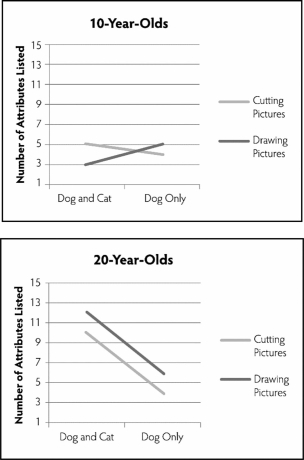(The first paragraph is repeated from earlier.The second paragraph is specific to the new set of questions.The first paragraph is necessary to set up the original study. )
Dr.Elder was interested in the way people recognize objects as members of categories.For example,what makes us recognize a dog as being a dog and not a cat? More specifically,he was curious as to whether people think about categories in a more complex way if they contemplate an "opposite" category first.For example,does a person think more differently about the category of "southern" if they are also thinking about the category of "northern"? He is also curious as to whether people categorize differently if they are exposed to category members compared with generating category members.Dr.Elder has four groups of participants (with 30 people in each group) .In Group A,participants were told to cut out pictures of dogs and cats from magazines.In Group B,participants were told to cut out pictures of just dogs from magazines.In Group C,participants were told to draw pictures of cats and dogs.In Group D,participants were told to draw pictures of just dogs.After doing this for 30 minutes,participants in all groups were asked to list the attributes that define the "dog" category.Having a higher number of attributes listed was considered to be an indication of thinking about the category in a more complex way.
Dr.Elder also is curious as to whether categorization happens similarly for children as it does for adults.As such,he recruits a group of 10-year-olds and a group of 20-year-olds to participate in the study.The results are below.

-Based on the graphs above,why should Dr.Elder conclude that there is a three-way interaction?
Definitions:
Obsession
An intrusive and persistent thought, urge, or image that repeatedly enters the mind, often causing distress.
Manic Episode
A period of abnormally elevated or irritable mood, increased energy, and other specific symptoms that significantly impact functioning, associated with bipolar disorder.
Autism
A neurodevelopmental disorder characterized by difficulties in social interaction, verbal and non-verbal communication, and repetitive behaviors.
Self-Absorbed
Excessively preoccupied with oneself and one's own needs, often at the expense of others.
Q1: What is a comparison group? What kind
Q2: The addition of a group that does
Q2: Dr. Smitherman conducted a study 5 years
Q5: Explain how a masked or blind design
Q14: Having a representative sample is most important
Q17: Cindy's advisor recommends that she contact several
Q36: For her research methods class, Serena plans
Q44: Which of the following is the most
Q51: Provide an example of each of the
Q51: Which of the following is a benefit